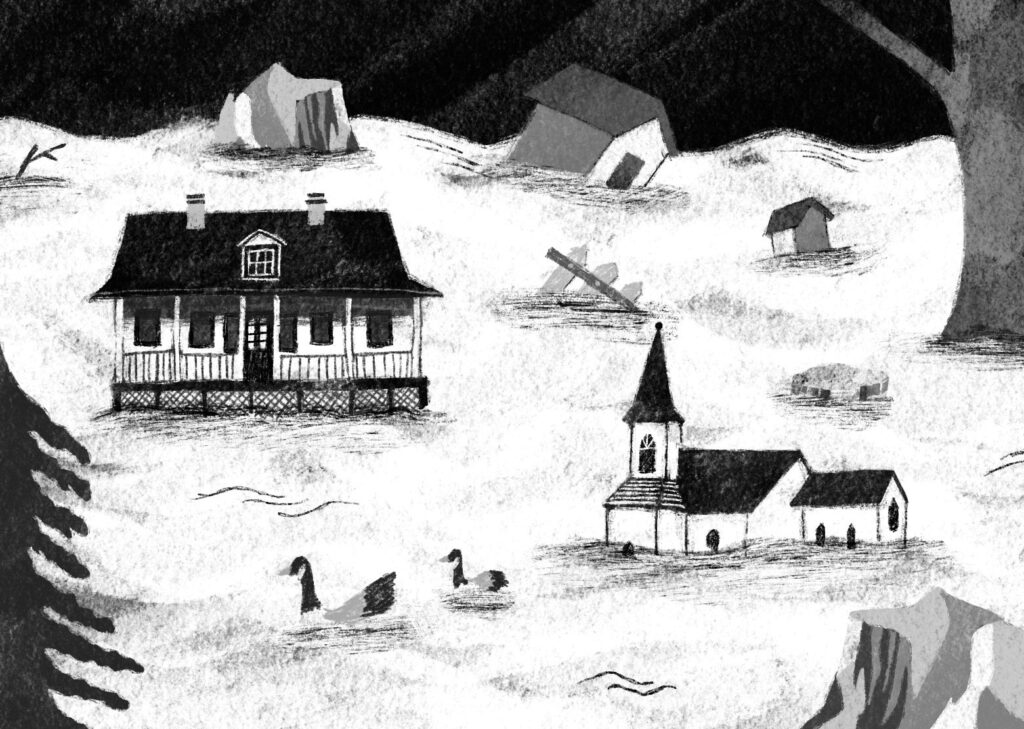Charles Bayly, the first Hudson’s Bay Company overseas governor, founded what was originally called Moose Fort in 1673. The second North American trading post set up by the HBC, after Fort Rupert in northern Quebec, and later renamed Moose Factory, it is the oldest English settlement in what became Ontario. Several historical buildings are still standing, including a powder magazine, an HBC staff house, and a restored blacksmith’s shop from 1740, which the Canadian Encyclopedia speculates is the oldest wooden building in the province.
Jean Pierre Chabot is fascinated by Moose Factory’s link to early Canadian history. The author and policy analyst spent part of his childhood in this community of 2,500, on the southern third of Moose Factory Island, not far from James Bay, and returned there to work as an adult. With 1894: The Deeper Story of Moose Factory’s Great Flood, he delves into a tragic event that remains “relevant for understanding concerns for the present and future.” Along the way, he examines Moose Factory’s relationship with the seasonal breakup, when blocks of ice rushing downstream can result in fierce water conditions each spring.
“Rivers breathe,” Chabot writes. “Some slowly, others rapidly. But all rivers breathe. They inhale and exhale with every ebb and flow of their waters. Northern Ontario’s Moose River is no exception.” Residents of Moose Factory and nearby Moosonee know this, yet many “dismiss the risk of flooding for about 350 days a year.” As Chabot observes, “It’s only for about 15 days a year — or 14 days in a leap year — that the uncertainty of break‑up crosses most peoples’ minds.” When the unknown does cross their minds, it’s often in the form of betting pools: “When will it happen, as opposed to how will it happen.”

Hudson’s Bay Company officials expected it would take months to recover.
Nicole Iu
While the breakup has long marked the calendar in Moose Factory, floods resulting from it are comparatively rare. Significant flooding occurred in the community in both 1826 and 1857. Intense conditions in 1859, 1893, 1917, and 1931 also led to inundation. The construction of hydro dams “caused a sort of amnesia in the river” after 1960, with the 1976 breakup being a notable exception to its faded memory. None of this, however, compares to what happened in 1894.
On April 28 and 29 of that year, Moose Factory residents “held their breaths. . . as the Moose River topped its banks.” In some ways, HBC employees had anticipated a battle of ice and water, making reference in their journals to the weather turning “beastly,” with “heavy showers and wind,” on April 20, and to depths that “rose a good deal” on April 26. The cannon that HBC used to signal the breakup was prepared, “calling any who might be hunting geese on the river, and warning them that they were in danger,” as the newly installed bishop, J. A. Newnham, recorded in his diary.
William Broughton, who served as postmaster, noted in his journal that the ice melted rapidly and led to the river and its tributaries breaking in unison and sending all their ice down upon the delta in one fell swoop: the worst possible scenario. The HBC journal says ice was “piling in some places to nearly 50 feet on the shoals.” People deserted their homes; some visiting Cree families “huddled” in the blacksmith’s forge and carpenter’s shed at the fort, on slightly higher ground. St. Thomas Anglican Church was filled with mud, leading to the cancellation of services and destroying songbooks. As for Newnham and his family, the water rose so rapidly that they were trapped in their upper flat for an entire day until they were “fetched in boat.”
What caused this “king of floods,” as Chabot dubs it? HBC records don’t provide specific answers, but earlier documents foreshadowed such an event. In one, a provincial government report from 1890, the mine manager and explorer Edward B. Borron wrote, “Ice jams are of frequent occurrence in the lower stretches of all the rivers which flow into James Bay. . . . All the rivers and streams are, more or less, liable to occasional obstruction by ice, drift-wood or landslides in the spring; and in view of such possibilities, settlers should be careful to select sites for their dwelling houses where they will be in no danger whatever from the floods thus occasioned.” Chabot suggests Ontario officials should have heeded this red flag.
Chabot cites the experiences of several residents, including Thomas Hamilton McLeod and Alice Fletcher, neither of whom had actually been born yet. Did events surrounding the breakup cause the premature birth of McLeod just days after the waters receded? What did Fletcher experience in the womb that shaped her life after she was born that October? Nobody died in the flood, though one company man “nearly lost his life in an attempt to remove ice from the slipway behind the Mink,” an HBC schooner. Countless others risked their safety “to secure their families, belongings, property, livestock and livelihoods.” An HBC journal entry from May 2 predicted it would take months if not years to recover.
Decades later, an elderly Cree woman named Ellen Smallboy was interviewed for a book “about the old ways of life.” She was forty-one at the time of the flood and may well have witnessed the events first-hand (some Smallboys certainly did). Strangely, she was not asked about those turbulent two days. But even without her potentially illuminating perspective, Chabot has written an engaging account of Moose Factory and the great flood of 1894.
Michael Taube is a columnist for the National Post, Loonie Politics, and Troy Media. Previously, he was a speech writer for Prime Minister Stephen Harper.

